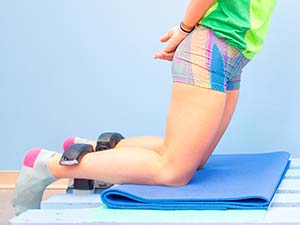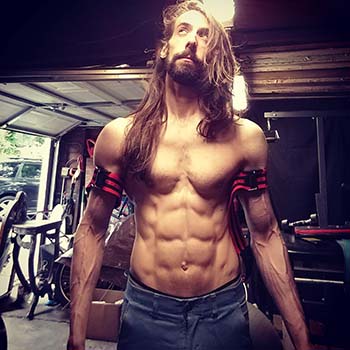Blog
Nordic Curls
Humbling and effective, Nordic Curls are amazing for your hamstrings.

Even before it was a hashtag, the Nordic Ham Curl was being used to strengthen and rehabilitate both athletes and non-athletes. And not just in Finland, Denmark, Norway, Sweden, and Iceland (known collectively as the Nordic countries), but the world over.
But why is it so great?
Get ready to find out, once and for all.
What Is It
The Nordic Ham Curl is unique from other hamstring exercises (except the GHR, discussed below). For one, it’s a bodyweight exercise. Also, whereas Romanian or Stiff-legged deadlifts are hip-dominant movements, the Nordic is knee-dominant.
And unlike a Seated or Lying Leg Curl, which does focus on the knee movement, the Nordic Ham Curl sees your lower leg immobilized while the rest of your body moves through space.
The movement is performed by kneeling on your knees on thick padding while a horizontal support such as a loaded barbell or a partner holds your feet/ankles in place. Moving at the knees only and keeping your hips locked or mostly locked, you start upright and then allow your upper body to tip forward at the knee joint (not the hips) as though you’re about to fall on your face. At this point, your hamstrings engage or “activate” in order to try to control your descent.
Very few people can create enough tension in the hamstrings to completely control the eccentric (i.e. the downward movement), so the hands are used to assist in the eccentric until the torso is about parallel to the floor, prior to helping you start the concentric (upward movement).
Then, the actual “curl” component of the exercise begins when you try to raise yourself back up to an upright position using only your hamstrings without bending your hips.
It’s hard. It’s really hard. But it’s worth being humbled because the results are so numerous: carryover to squatting, deadlifting, and running, superior knee health, greater connective tissue strength, and, of course, bigger hamstrings.
Difference Between the Nordic and the Glute-Ham Raise
The Glute-Ham Raise and the Nordic Ham Curl are very similar. There are three main differences between the two exercises, though.
The first is practical: the GHR is generally performed on a GHD, or Glute Ham Developer, an expensive and bulky piece of equipment absent from most commercial gyms, never mind home gyms.
The second difference is in the movement itself. Because of the rollers on a GHD bench, the knee is allowed to move downward toward the floor, resulting in greater knee flexion, thus creating more tension in the lower part of the hamstring than would be possible if the knee was immobilized. This added tension makes both the concentric and eccentric parts of the exercise easier.
One benefit is that, generally, more GHR reps can be performed than Nordic reps in a given set if pure bodyweight is used. Also, the kneecaps are sometimes more comfortable performing the GHR because there is less pressure directly applied to them as there is during the Nordic.
The main drawback, though, is tied to the main advantage of the Nordic BECAUSE of its lack of knee movement: no other exercise can achieve such a high degree of tension on the hamstring in a stretched position, which is what endows the Nordic with its superior preventative and rehabilitative uses, which are discussed below.
So those are the differences! They are both great exercises, but there’s no question: the Nordic is easier to do at home unless you want to buy a GHD bench. Then you can do both!
Setting up the Nordic Ham Curl at Home or in the Gym
Whether your goal is primarily hypertrophy or injury prevention, you need to secure your ankles in one spot and have your knees on adequate padding.
It’s also helpful, especially for hypertrophy, to allow for assistance throughout the movement. This allows you to a) perform more reps, and b) perform fully controlled eccentrics and concentrics throughout the entire range of motion including at the bottom, which is the weakest point.
There are two great ways to hit all of these birds with one stone. One way involves using a pulldown machine and the other way, shall we say, improvises a bit more.
First the pulldown version. If your gym has a pulldown machine or you have the Ironmaster Cable Tower PRO in your home gym, first make sure there’s some weight engaged on the pulldown apparatus and secondly attach a tricep rope handle to the pulldown cable.
Then, kneel on the seat pad facing out and place your ankles under the knee supports to secure your lower body. Grip the ends of the rope and hold them tightly in front of you, close to the chest. Then, begin your descent.
It will probably take a few tries and adjustments to find the right amount of weight, but you’ll be doing full-ROM, forehead-vein-popping Nordics in no time.
The other method of doing Nordics at home or in the gym has thankfully already been “improvised” for you, by Dr. Bret Contreras. In this video, he demonstrates both the setup and execution. Pick up Ironmaster's multi-use Olympic bar here. Of course, if you have the IM2000 self-spotting machine, you're already set to quickly lower the bar to a comfortable bench height and get going!
Of course, it is also possible to perform the Nordic without any assistance such as cables or bands. In this case, you would use your hands, as described above.
Nordic Curls for Hypertrophy
For building muscle, you can treat Nordic Ham Curls as you would any other hamstring exercise. Generally, in a lower body workout, they would follow any main compound movement you perform such as a squat or deadlift.
If the reps are assisted, performing 3 sets of 7 to 10 reps is ideal because it will allow you to reap the benefits of the controlled eccentric as well as the insanely difficult concentric. If the reps are unassisted, 3 sets of 6 with a more-controlled eccentric plus plenty of effort on the concentric is a good starting point.
Using the Nordic for injury prevention and rehab/pre-hab
Specifically for runners and running sports, the Nordic Ham Curl is useful for both prevention and rehabilitation (https://pubmed.ncbi.nlm.nih.go...). This is because it strengthens the hamstring in a lengthened position.
The hamstring lengthens during knee extension: in other words, as you step forward, the ham gets longer and helps produce force to deliver the next step.
However, this lengthened position is when the muscle is at its weakest. Hence, hamstring strains are common when the hamstring is unable to support the amount of force it’s being subjected to in this weaker position.
This is precisely the position in which the Nordic Ham Curl is able to strengthen your hamstring more than any other exercise.
Therefore, when using the Nordic for prevention or rehab, you only need to focus on the eccentric portion of the movement, which is the coming-down part. Three sets of six reps with slow, controlled, and pain-free or mostly pain-free (https://pubmed.ncbi.nlm.nih.gov/31253060/) movements is ideal. Always follow the advice of your physical therapist or other medical professional.
Wrapping Up
From the innovations of Ikea and Volvo, to the thespianism of Mads Mikkelson and Liv Ullman, to the music of Björk, Jean Sibelius, and some of the roughest death metal imaginable, the Nordic countries have done it again!
Try the Nordic Hamstring Curl and reach Viking-level realms of strength, athleticism, and injury prevention!
About the author

Mark Ludas CPT is a NASM-certified personal trainer with a decade of experience in the fitness industry. After an asthmatic childhood, Mark discovered his natural aptitude for fitness in his late twenties. At age 36, he accomplished a 300+ pound conventional deadlift and 280+ high-bar squat as a 6’5” 170-pound ectomorph on a fully vegan diet, all after just one year of proper self-programming. Mark is the founder of Resistance Quest Fitness, established in 2016, and the creator of the Paralinear Method of strength training. Additionally, he is a writer, actor, model, and musician. Find him on Instagram, Facebook, Youtube, and at www.resistancequest.com.

198 Comments